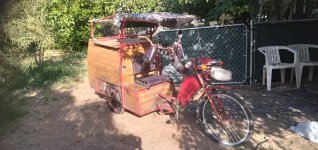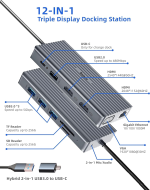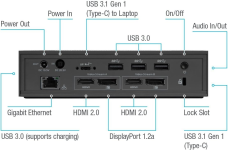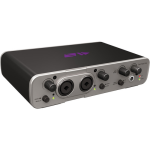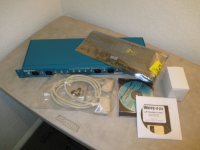Have to reply to the other post later, but for now:
I've listen to the very last version - the low end is quite good, even agressive (which a liked). It's a good work with the bass!
Thanks...I'm still working on consolidating the three different bassline parts (subbass, which is just short sinewave hits at specific beats to accentuate the WHOMP, a trick I learned from another SONAR beta tester but never tried in the couple decades since then, main bassline, the closer-to-midrange bass that's arped like the main lead (is actually almost exactly the same instrument, just a couple octaves lower and differently filtered), and the accent bassline, the deep boomy bass that fills the spaces, the one the song starts out with).
Eventually they should all flow together and keep the beat of the song steady but evolving.
There are places where originally I accidentally misaligned the arp of the main bassline with the drums, where you hear the pattern / rhythm change...but most of them I liked and kept as they evolve the music over time and keep it unboring.
Being a metalhead i can't actually give you a "breaking down" kind of review since a don't fully understand the very language of the electronic genres. But i've liked it in general, my mind was filled with some emotions and pictures and i've tap my feet a little.
If it gets anyone to unconciously follow the rhythm, that's a good sign I'm on the right track.

I don't know the language of *any* of hte musical genres, or even the genres themselves. I play with sounds and record the notes that make interesting combinations (to me) and then play with those until something resembling a song comes out the other end of the process.

What any of it is actually called...I know very little of. Since I have never found anyone actually interested in collaborating (thought I did a couple times, but was wrong), I haven't used up time learning to communicate things about it that I can better spend making it.

Soundwise the work is solid. What kind of studio monitoring solutions you using for now?
My main speakers are two ancient Acoustic Research Powered Partner AR570's that I bought from my dad back in the 1990s. They used to sit on top of some other AR cabinet speakers behind my big ASR88 workstation keyboard, but nowadays they rest in a cozy of throw pillows at the corners of the head of my bed, which is where I almost always am when not at work (so I can doze and wake to get enough rest to keep working for $$ while I also accomplish a tiny bit of the things I actually want to do). The speakers have less reflection-interference from the nearby walls this way, too, so I get a cleaner sound, and being behind me instead of in front is a bit weird still, but makes me feel more like I'm in the middle of the sound (the way you do when wearing headphones).
They're heavy, metal-cased, and I run them off wall AC power but they can also be run off "12v" systems. Just a regular line-in RCA jack on each one. Each unit is self-contained, so ther'es no left or right unit; there are multiple ways built in to mount htem to things, but I've always used them just sitting on foam blocks or stacks of mousepads to isolate them. I keep all the knobs centered for tone and volume, for consistency when mixing. My knobs are slightly different than those on the images below, as mine have separate treble and bass controls, and then a volume knob, with power switch on the back. Mine are the actual Acoustic Research version before Advent bought them and began cheapening everything.
I don't have a useful sub--I have two different labtec computer subs given to me by different friends over the years, but neither one is useful for music mixing--I get better response out of the AR's. I often see subs at goodwill, usually from assorted home theater systems, but I never know what they are like or if they're blown, etc., and can't look them up till I"m home, and if I find one would actually be worth getting, after I check and go back they're never still there.
All the pics below except my trike are grabbed off randomly-chosen google search results.
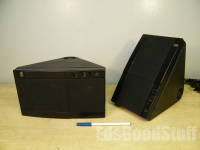
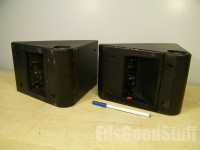
I also use some AKG K240 "studio" headphones for editing certain things, and for recording stuff that has to be with the effects thru the computer so the latency of me hearing myself play vs what's coming out does'nt affect my playing as badly. But I try never to mix with them because the result does'nt sound very good except in good headphones--on speakers, especially not so great ones, it can sound absolutely terrible.
My "test" speakers (to test mixes on for others to hear, because I don't want to make a mix that *only* works on my speakers) are some so-so TV soundbars and cheap computer speakers (the best of which is a tiny Dell speaker bar that mounts on many Dell LCDs), all from goodwill (thrift store).
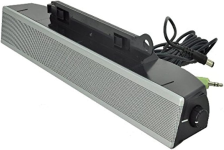
Two Vizio SBs of very similar make that sound almost identical; don't recall the models but they look like this except I don't have the remotes. One is RTV-glued to the top edge of my monitor (was the fastest, easiest way to mount it), and the other is secured behind my head on the SB Cruiser trike; you can see it in the image below the speakers, hoseclamped to the canopy frame:


The soundbars are ok, but the speakers are pretty small so they don't reproduce the bass/etc like the AR's do.
My only sound treatment for the room at present is that the furniture is arranged "jumbled" in height and position such that it happens to help with sound scattering (wasn't intentional) and I have thin hangings (with pics of wolves on them because...) that help absorb some of the high reflections, along with some acoustic cieling tile at certain points that I found by trial and error to minimize reflections around the room. I have old couch cushion cores to stick in the windows and foam blocks saved from assorted cushions and chairs being scrapped tucked on top of things in the room and behind them, that also help with reflections and certain sound problems, all just determined experimentally "by ear". I don't have bass traps but would like to set them up someday along with real acoustic treatments. $$.... :/ (mostly, having a really small mostly-cubical space is just hard to do much with). There is software out there to help with room testing and setup but I have yet to get around to doing it.







